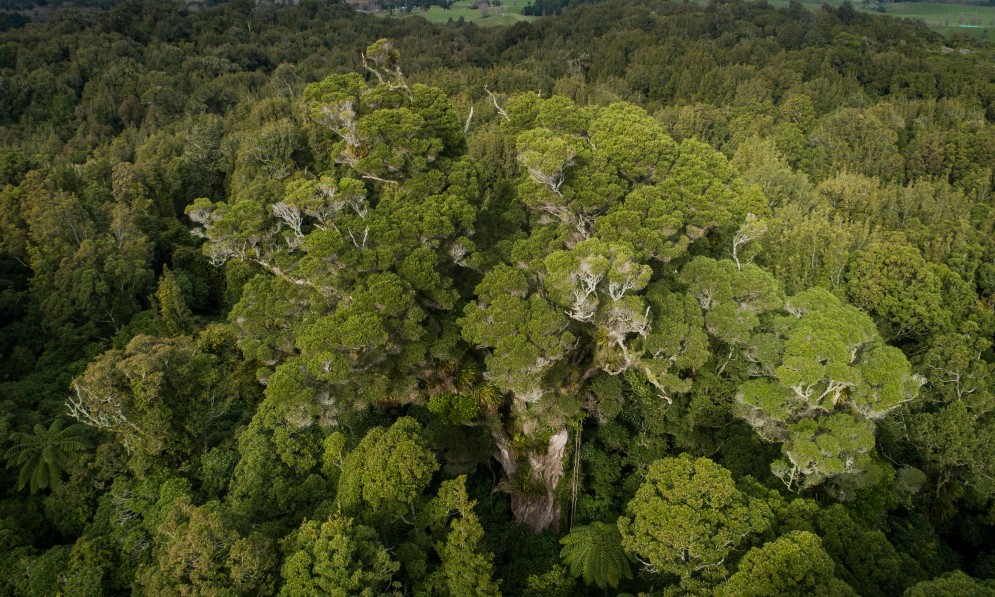A 1000-year-old northern rātā in Forest & Bird’s Bushy Park Tarapuruhi sanctuary is the only New Zealand tree to feature in an international writing project called 26 Trees. Known locally as Rātānui, the ancient tree inspired writer Jayne Workman to question how it has survived so long in a landscape dominated by human activities.
Forest & Bird magazine
A version of this story was first published in the Autumn 2020 issue of Forest & Bird magazine.
A biting 3°C start to a June morning, the coldest of the year, gives way to a brilliant day, exuberant, cloudless, blue. Opening the gate into Bushy Park Tarapuruhi, I wander wondrous forest galleries – lianes twining into perfect archways, intricate ferns fountaining overhead, palms lining the pathway’s curve.
As I begin the gentle descent to Rātānui (Big Rātā in te reo Māori), sun filters through its ravaged canopy, creating a pool of light in the dense green. Flanked by kawakawa, ponga, and sapling sentries, the vast, swarming trunk is greyed and cracked, bark rough, peeling, scarred. Epiphytes, bursts of bearded green, perch in its craggy creases. Above, a leafy breeze. Here, just the flutter of rare tīeke around me.
Rātānui is a northern rātā, a slow-growing native hardwood known for its stature and scarlet summer flowers. As a tiny seed, it drifts from the forest canopy, taking root on a mature tree. Vines reach downwards, twisting then gradually fusing around it, leaving a hollow in its shape when it dies, memorial to another time.
Within
Fern’s filigree, looping lianes,
wintry light through waving leaves. Dappled, wild-beaten, generous bark,
tīekes’ flutter-dance around.Giant roots in earthbound fuse,
thick-skinned, craggy, centuries’ crease.
Sunlit sway far above,
distant rustle, distant blue.Plunder, clearance, roar and scream, thunderous crash, gnawing teeth, eyes-shut sigh as millennia fall, ghosts in the hollow of your slow embrace.
Rātānui.
Here.
Still.
As Rātānui’s life started, the first people arrived in Aotearoa. Māori built settlements, healing rheumatic joints and ringworm with steeped rātā bark, making little impact on the native forests still covering 80% of New Zealand. Centuries later, with the advent of Pākehā, logging accelerated. Woodsmoke from clearance fires hung in the air and the rasp of giant two-man crosscut saws sounded through the trees. In a grim turn, rātā, prized for durability, became axe handles, sawmills, tramways transporting logs out of the bush.
Somehow, Rātānui survived. Searching the archives, I found an extraordinary document, on vellum, transferring 966 acres from Uru Te Angina to James Moore for £483 in 1880. Within Moore’s huge estate, famed for cattle and horse-breeding, 245 acres were spared, today’s Bushy Park.
Crucially, in 1962, his son Frank left the rainforest and Edwardian homestead to conservation organisation Forest & Bird. By the 70s, rātā, and iconic cousin, pōhutukawa, faced extinction. Now, Rātānui, although severely damaged, is protected, along with its ancient community of native birds and trees by a predator-proof fence against rats, stoats, and possums that could destroy it in two years.
Driving away, I see the pastured countryside with different eyes. The fields seem bereft, the trees, lonely. Behind it, I notice the invisible hand of human intent. I understand more clearly what’s missing – but, also, what we still have. In places. We should go there, all of us, whenever we can, I found myself thinking as I left.
About the author

Jayne Workman is a UK writer living in Whanganui who was invited to write for the 26 Trees project She joined Forest & Bird after her inspiring visit to the ancient forest at Bushy Park Tarapuru.

